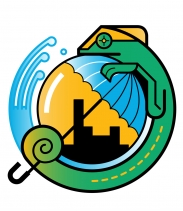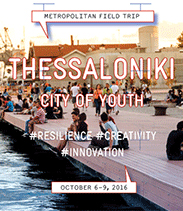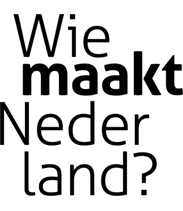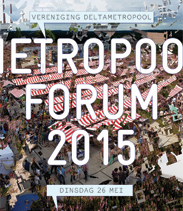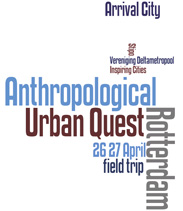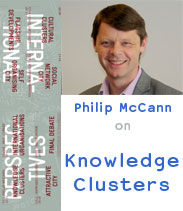Cultuur Clusters als Activa voor Steden, Maakbaar en Planbaar? is een promo- tieonderzoek naar de invloed van lokaal ruimtelijk beleid op het trans- nationale netwerk van culturele clusters en de creatieve klasse. In het kader hiervan is promovendus
| Yvonne Rijpers | met stagiair Isabel Neumann naar Berlijn gereisd, om eerste indrukken op te doen over hoe men hier met cultuurclusters omgaat.

Dit onderzoek maakt, net zoals Atlas ABC, InteractieMilieus en the International Perspectives lezingenserie, onderdeel uit van het thema Het Programma van de Metropool. Het project wordt mede mogelijk gemaakt door een subsidie van het Stimuleringsfonds Creatieve Industrie en uitgevoerd i.s.m. de Erasmus Universiteit Rotterdam - faculteit FSW.
Information / downloads
| Yvonne Rijpers | (project manager)
| Cultural Clusters Research - an introduction | (PDF, English)
Gerelateerd
| AFFR Special: Kultur = Kapital | (11 Oct, 2013)
| het Programma van de Metropool |
| tIP #1 Cultural Clusters, lecture by Bernd Fesel |
| Generating Culture: Roots and Fruits | (VDM, 2005)
| Creatieve Steden! | (VDM, 2002)
This first trip to Berlin, described below, brought many new insights into the Berlin cultural economy and the stakeholders involved. The interviews and experiences, during this week, provided us with a lot of material for further development of the research on cultural clusters and expansion of our network. Many ideas on how to proceed were born and shortly the first product of this research into cultural clusters will be published.
| 25/5 Arrival | 26/5 KULTUR:STADT | 27/5 Stadtentwicklung | 28/5 Chamber of Commerce | 29/5 Four Interviews | 30/5 Berlin WTF | 31/5 Exploration |
May 25, 2013 – Arrival at Neukölln and Friedrichshain
After a swift train ride from Rotterdam, perfectly timed for reading the book I was given, we arrived in a drowsy, rainy Berlin. A bit disappointed, since in my head, the sun always shines here. Our apartment is situated deep in Neukölln, where the new ‘hipness’ of this neighborhood, that has changed the Northern part thoroughly, has not yet touched base. Near U/S-Bahn station Hermannstrasse, all we find are numerous Turkish bakeries, 24hour shops and little betting houses. Our apartment turns out to be spacious, light and … cold. Supposedly lots of Berlin houses decide to turn off their heating in summer - according to date this is, not according to actual weather. But well, the ‘Energiewende’ has to start somewhere …

For dinner we change locations and move to Friedrichshain. In the last fifteen years the Simon-Dach-Strasse, where our restaurant is situated, has changed from a rather derelict place - with houses heated with coals and here and there a DIY café - to a tourist hub with countless bars, restaurants and the like. One is surrounded by more languages than one can recognize. Despite it being Saturday, and hence the ideal night to go clubbing, we decide to lay our tired heads to rest and get up early the next morning.
May 26, 2013 – KULTUR:STADT and 'Tatort Kneipe'
We start the day with the exposition | KULTUR:STADT | (Culture:City). Today is the last day of this architectural exposition which shows the impact of art and culture on cities and architecture. It highlights some interesting landmark architecture for cultural purposes as well as it poses some critical comments on the (lack of) embedding these buildings in their social and spatial surroundings. After this, we move on to some bottom-up cultural entrepreneur- ship: the weekly flea market at Mauerpark – a paradise for secondhand (DDR) clothing, glasses, furniture, DIY-made jewelry, food and drinks from all over the world and what more. When the weather is nice, there is a big Karaoke competition in the park as well, which is hilarious to witness. However, it’s no Karaoke weather today, it is pouring. So we go for what is supposedly the best coffee in Berlin, at Bonanza Coffee Roasters in Oderberger Strasse (www.bonanzacoffee.de), with a beautiful interior designed and made by Rotterdam-based Onno Donkers. Oderberger Strasse is yet another example of how fast Berlin has been changing and gentrifying. Every time I return here, more fashion shops and bars pop up.

In the evening we join a German tradition; we go to a bar and watch the newest episode of Tatort (a series of crime movies produced by the ARD) on a big screen. Internet is helpful for finding a good ‘Tatort Kneipe’ – per city there are lists of the best places to witness the latest crimes and how they are fought.
May 27, 2013 – Interviews at Stadtentwicklung Berlin and TU Berlin
It's Monday, our first day of interviews. We go to the Senatverwaltung für Stadentwicklung und Umwelt – the city department for urban development and environment (www.stadtentwicklung.berlin.de), one of Berlins municipal departments involved in developing policy towards the creative economy. Just before the meeting, we take a small walk in the neighborhood and were astounded to discover a bear in the little park in the middle of the city. It turns out there are two real Berlin bears in Köllnischer Park – one of these nice random discoveries when wandering around Berlin.
Monica Faltermaier tells us about the role of Berlin authorities in promoting the cities creative economy. She emphasizes the facilitating and open character of Berlin policymakers for experimental uses in urban space, who often make ‘the creative takeover’ possible. A very recent development is an approach towards the selling of publicly owned land / premises – where no longer the highest bid counts, there should also be a concept and a place for the creative economy in a new development. Which kind of creative industries, or which sector, is not specified. Furthermore, this department is mostly involved in encouraging temporary use (Zwischennutzungen) and not significantly involved in activating policies for creative industries.
For dinner, I meet up with my former professor at the University of Amsterdam, Enrico Gualini, who is now a professor of planning theory at the TU Berlin. We have dinner at a Tadzhikistan restaurant, where one sits on cushions on the floor. The interior is so perfectly traditional that you seem to be in another world and another era.
May 28, 2013 – Interview at Chamber of Commerce Berlin and cultural workplace visits
Today we meet with Jürgen Schepers of the Industrie und Handelskammer Berlin – the Berlin chamber of commerce and industry (www.ihk-berlin.de). More than any other chamber of commerce in Germany, the IHK Berlin is involved in promoting the creative economy of the city. In Germany, every company, entrepreneur, freelancer with a turnover of more than 17.500,- euros is obligated to register at their local IHK and pay a fee. With these fees, the IHK advocates the interests of entrepreneurs in local politics and provides consultancies on start-ups or the enlargement of businesses. Recognizing the rising numbers of cultural entrepreneurs in Berlin, the IHK tries to foster good conditions for their further development in the region. Practically, the IHK works as an in-between for the cultural entrepreneurs on the one hand and the policy makers and politics on the other.
Jürgen Schepers has been working in the advertisement and media business for years, so he knows the threats and chances for cultural enterprises in Berlin and has a good network in this scene. In his current position, his focus is on improving the economic development of the cultural economy, for the benefit of the cultural entrepreneurs as well as the city of Berlin as a whole. He is actively involved in advising (among others) universities, governing institutions on how to sustain Berlin’s creative potential. Furthermore, he offers guidance to cultural entrepreneurs, helps them train their skills (i.e. running a business) and organizes information and network events on the more serious part of the cultural business (insurances, fees, licenses, etc.). The approach of the Berlin IHK could be an interesting example for some Dutch cities.
The rest of the day we spend among the Berlin typical mix of hipsters, tourists and the cultural class: we worked at St. Oberholz, a Café in Mitte that – with its fast WiFi, big tables, plugs everywhere and great coffee and food – is the perfect working room for all officeless entrepreneurs or those in-between meetings. St. Oberholz and similar places which provide place and infrastructure are breeding grounds for the exchange of cultural workers in Berlin and front- runners in today’s co-working spaces. We’ll have a closer look at some of these later in the week.
May 29, 2013 – 4 Interviews: NEMONA, Inpolis, Georg Simmel Centre and IRS
This is going to be the most intense day for us this week with four planned interviews, one of them in Erkner, some 40 minutes outside Berlin, requiring some serious public transport planning and a strict timetable.
Our first stop is NEMONA, Netzwerk Mode & Naehen Neukölln - fashion and sewing network of Neukölln (www.nemona.de). Daniela Fleig and her colleague Sabine Hülsebus, both working at INPOLIS (www.inpolis.de), build up links between fashion designers, seamstresses and tailors, all well represented in Neukölln. However, before NEMONA started, they benefitted very little from their close proximity. NEMONA aims to bring together innovative design and traditional handicraft for the production of collections and functions as a network among designers, organizing meetings and joint events as a display for their works. The inspiring thing about NEMONA is that it bridges a gap between the hidden talents among the Neukölln population. In doing so, it has a positive impact on the neighborhood by on the one hand getting seamstress (back) to the job market and on the other hand supporting the establishment of fashion ateliers, shops and so on. The project has been running a little over two years now and will end this September. Authorities and entrepreneurs experience it as a big gain for Neukölln, so a sequel (again funded with EU-money) will immediately follow. The next project will be setting-up a database of all the production talents in Neukölln. NEMONA further invests in developing a sustainable network for exchange between the formerly separate worlds of design and tailoring. In this respect, Daniela is very interested in international exchange; a similar project in one of our Dutch cities would be very appealing.
At the Inpolis office in Prenzlauerberg, we meet Daniela’s colleague Ares Kalandides. Ares is both a university teacher at the Hertie School of Governance in Berlin as well as a project leader in creative urban projects. He used to be in the Senate’s advisory board for cultural policy, but is not very convinced of the supportive schemes pushing the creative economy in Berlin. Central problems to him are a lack of transparency in the current strategies to foster this sector and the poor organization of the creative entrepreneurs. The different (groups of) entrepreneurs often have conflicting goals and are (as they are often rooted in opposition and sub-cultures) difficult to address as a group, let alone being steered.
After the meeting with Ares we move on and have coffee with Bastian Lange. Just like Ares, Bastian is a university teacher (at the Georg Simmel Centre for Metropolitan Research at the Humboldt University), a researcher as well as a professional in creative urban planning projects (www.multiplicities.de). Bastian tells us about several bottom-up initiatives in Berlin that are worth visiting. Moreover, we get into an interesting discussion about the concept of clustering – for what and whom it is useful and/or useless – and whether or not it is a good concept for analyzing the creative economy. For me, lots of food for thought on my project and the research outline as is. It would be very interesting to cooperate and exchange practical and theoretical knowledge with Bastian.
For our next meeting we take the train to Erkner, a little place southeast of Berlin, where we are expected at the IRS, Leibniz-Institut für Regionalentwicklung und Strukturplanung (www.irs-net.de). IRS is an independent research institute, which is publically funded and has existed since the DDR time. It is located in a huge building, partly renovated, partly left to the test of time. The road there is full of obstacles and much longer than needed if the infrastructure would work with, instead of against us. The IRS has been doing quite some clustering research, mostly on technology clustering and quite quantitatively oriented. Gaining understanding of how the IRS approaches its research tasks – for instance how they define samples and collect data – is very informative. Elaborated internal structures (5 boards, each focusing on one research topic, and one cross-research on a shared problem) but as well the funding situation, enable the IRS to conduct not only practical but also fundamental research. Even though the institute is not directly engaged with cultural clustering, we got some interesting suggestions for how to approach the specifically local and trans-local factors in clustering for our research project.
May 30, 2013 – Interview at department Economy, Technology & Research and Berlin Exhibition
Our ancient German bicycles take us to Schöneberg, to a beautiful old building with lots of marble. It strikes me that, contrary to the Netherlands, one can just walk into the buildings where municipal services are located, without having to identify, get a visitors pass or anything. This is what ‘public’ buildings, of public administration, should be like.

This is our last interview of the week, at the Senatveranwaltung für Wirtschaft, Technology und Forschung - the department for economy, technology and research (www.berlin.de/sen/wtf/). This part of the public administration in Berlin is the most involved in the policy for the creative economy. It has been developing strategies on the support of innovative businesses since 1997, but the focus on creative economy really came about in 2005. Mrs. Fiedler, our host today, has been involved in these policies for quite some time. To oversee the manifold of tasks and sectors, the department has an expert for each of the eleven officially identified sub-sectors. Mrs. Fiedler’s expertise and main focus lies with publishing and the book market. Since the department (as the whole Berlin administration) doesn’t have a lot of money to divide; it works in first respect as an in-between for the (networks of the) cultural entrepreneurs, policymakers, international networks, events and so on. Most projects that are supported are made possible by co-funding of the European Union – that is overall where a lot of money for the creative industries in Berlin comes from. Berlin is, according to EU guides, situated in a structurally weak part of the European Union, which creates a relatively comfortable funding situation for local authorities and enterprises. Shortly, the EU-programs will be revised, and it is unknown if there will be just as much money available for Berlin and its creative economy.
Each year local policy is internally monitored, however, this is not made public. Monitoring is only published if necessary for instance for EU-funding. The available reports, such as the Kulturwirtschaftsbericht (Cultural Economy Report) give an insight on the data on the Creative Economy in Berlin, and clearly indicate a positive development for most of its branches. However, these reports provide a restricted view: due to their little earnings, micro-entrepreneurs and many freelancers are not represented in the statistics. The growth of previously micro-companies into ‘real’ companies; changing names; and relocation of businesses make it difficult to draw an accurate picture. However, these official reports are the most reliable sources to get a quantitative understanding on the extent of the cultural economy in Berlin. Also striking is that there is no data on where the markets are. What is known is that there is a lack of market (demand) in Berlin for all the supply there is in the city, meaning the creative economy benefits from markets outside the city. The lack of more knowledge on where these markets are and what the market situation in Berlin is, strikes us as odd. After all, trying to make the creative economy beneficial for the city would also imply having a view of the market and how to influence that.
In the evening, we head to Friedrichshain for an exhibition of Rotterdam-based artists reflecting on the meaning of the Berlin capital and its characteristics (www.urbanspree.com). With its art, the collective aims to bridge a gap between Berlin and Rotterdam, touching societal research, design, interaction and street culture. Remarkably enough a Frenchman owns the gallery, so the public is a nice intercultural mix of artists and art-lovers. The exhibition approaches the atmospheres and images it stands for: the anti-attitude of young Germans and the still strong autonomous scene, the migrant-economies, the city with so much must-sees, and the place where you are continuously contributing to various street scenes.
May 31, 2013 – Exploring Kreuzberg, PlanetModulor, Betahaus and Pro QM
On our last morning in Berlin we find ourselves in one of Berlin’s most thriving neighborhoods: Kreuzberg, which has always been the centre of migrant economies and buzzing scenes in the city. However, it has also, like so many neighborhoods gone through a transformation and gentrification process. Today, it is home to some typical Berlin appearances. We first pay a visit to the Prinzessinnengarten, an urban garden situated at the busy roundabout at Moritzplatz (www.prinzessinnengarten.net). The garden is an oasis of green and peace, where the sounds of the cars luckily have a hard time fighting the sounds of the leaves of the newly planted trees. Its makers created not only a beautiful green space for the neighboring dwellers, but they also use the site to conduct workshops and offer educational projects on city, gardening and landscape.

Just across the street, we visit PlanetModulor (www.planetmodulor.de/pm/) established through a cooperation between small and medium sized entrepreneurs. It aims to give an economic and cultural impulse to the neighborhood by bringing goods, craftsmanship and services together with creative, cultural and social projects. Entering, we are first pleasantly surprised by the huge shop offering plenty variants of paper, sewing equipment, sheet metal, ply wood, and the likes. On the other side, we find a very well assorted bookshop and a cozy coffee place. However, there is more to this ‘Planet’; a wide range of co-working spaces and services for creative entrepreneurs for instance. There is an area for sewing, a workshop where cardboard and wood can be fitted, a copy and printing service… just to name a few. The top floors of the building are rented out as offices and studios, among others the German publishing house Aufbau Verlag is situated here.

Around the corner, we visit the Betahaus (www.betahaus.de), a famous co-working place in Berlin, which has existed since 2009. Betahaus measures 2000m2, with free Internet, fixed and flexible working places, meeting rooms, a café and lots of even space. Freelancers in the field of graphic design, computer programming, architects, photographers, academic researchers as well as lawyers, journalists, multimedia artists and bloggers currently work here. This concept has been so successful that is now widely implemented in other places. Betahaus itself opened satellites in Hamburg, Cologne, Barcelona and Sofia.

In the late afternoon we spend some time in Pro QM, a bookshop specialized in ‘city, politics, pop, economy critics, architecture, design, art and theory’ (www.pro-qm.de). Offering exchange on these topics, not only in the format of books and magazines, but as well as a site for public lectures and workshops, it is again an example of the typical Berlin hybrid spaces that serve and tie together multiple markets and function as local nodes for several scenes.
Information / subscribe to mailinglist:
PhD student | Yvonne Rijpers |
intern | Isabel Neumann |
Project partners:
The New Planning is a collaborative research project between Deltametropolis Association and TU Delft. A consortium of academic, civil society, government and market sectors is being created to meet the urgent need for a new model of strategic spatial planning that will keep the Netherlands at the forefront of territorial governance.

 Archief
Archief









